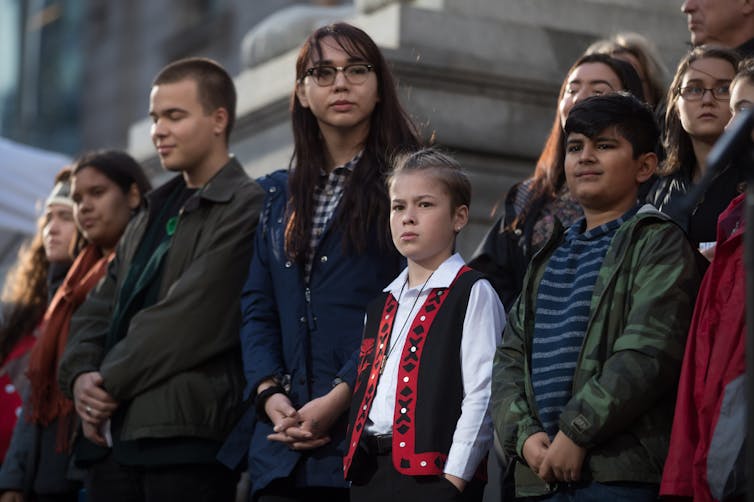┬ķČ╣┤½├Į the author: Karinne Lantz is a PhD student and assistant professor (part-time) in the Schulich School of Law at ┬ķČ╣┤½├Į.
Late last year, the that could have implications for countries around the world.
The case, , established that a countryŌĆÖs inadequate action on climate change can violate human rights. For the first time, a court imposed a legally binding target and deadline for a government to reduce greenhouse gas (GHG) emissions, by at least 25 per cent from 1990 levels by the end of 2020.
Urgenda was a major victory for climate justice activists, who have launched human rights lawsuits attempting to require governments to take more substantial and timely action against climate change. This landmark decision could prove influential in Canada, where similar cases will be decided.
Urgenda and Canadian climate litigation
There are now at least invoking human rights, including , in which the federal governmentŌĆÖs effort to have the lawsuit stopped before it goes to trial was argued last week.
Past Canadian based on other grounds have . But Urgenda may be particularly relevant to current litigation because it is based on human rights and in La Rose reflect the NetherlandsŌĆÖ unsuccessful arguments.
For example, Canada acknowledges the threat of climate change, but maintains that a court cannot order it to take action because climate change policies are for elected politicians ŌĆö not judges ŌĆö to decide. The government also argues that climate change is a global problem that Canada alone cannot solve.

The pending Canadian cases will require our courts to decide similar issues as Urgenda, including:
Does the right to life under the Canadian Charter of Rights and Freedoms require the government to take specific action on climate change?
Is it appropriate for courts to review climate change policies?
Does the concept of an individual but shared global responsibility overcome the ŌĆ£de minimis contributionŌĆØ defence?
Other issues have been raised in these cases that are not addressed here, including .
Why could Urgenda be relevant?
In Urgenda, the court concluded climate change poses a ŌĆ£real and immediateŌĆØ threat to the right to life, which the Netherlands has a legal obligation to address under the (ECHR). While this convention is not binding in Canada, Section 7 of the charter protects the right to life. Canada is also bound by recognizing the right to life.

The interplay between international and domestic law is , but the Supreme Court of Canada has established that charter rights should provide at least as much protection as corresponding rights under binding human rights treaties. It has also held that other sources of international human rights law ŌĆö including cases interpreting the ECHR ŌĆö may be considered in charter litigation. Finally, Canadian courts often canvass relevant foreign decisions.
These principles open the door for our courts to consider Urgenda relevant. And, if our judges think the approach to similar issues in Urgenda is persuasive, they could follow it.
Climate change and the right to life in Canada
That being said, Canadian plaintiffs still face significant obstacles due to how the the right to life under the charter has been interpreted.
For example, the courts would need to adopt a broader understanding of a ŌĆ£real or imminentŌĆØ threat, and to recognize that the government must take action to protect the right to life. As the law currently stands, the government is not required to take action to address indirect threats.
Read more:
But, this could change. The SCC to a broader approach in an anti-poverty case:
One day S. 7 may be interpreted to include positive obligationsŌĆ”. It would be a mistake to regard S. 7 as frozen, or its content as having been exhaustively defined.
In addition, the (in a different context) that the right to life under the International Covenant on Civil and Political Rights ŌĆö a binding international treaty ŌĆö can impose positive obligations on Canada. These decisions may leave room for climate plaintiffs to argue that our courtsŌĆÖ approach to the right to life is too restrictive and is falling below international standards.
Can courts review climate change policies?
In La Rose, Canada that the plaintiffs are asking the court to ŌĆ£step outside its judicial functionŌĆØ and become involved in ŌĆ£crafting a policy response to global climate change.ŌĆØ
This argument failed in Urgenda. In the Dutch Supreme CourtŌĆÖs view, an order to reduce GHG emissions was within its authority because it is the courtŌĆÖs role to review the reasonableness of laws and policies and the legislature remained free to determine what laws and policies to implement to meet the NetherlandsŌĆÖ obligations.
Canadian courts also often review the reasonableness of laws and policies. So, if climate change is considered a threat to charter rights that Canada must address, Canadian courts could follow the same approach as Urgenda. While the governmentŌĆÖs obligation to meet an emissions target would be new, elected officials would still decide relevant laws and policies.
The ŌĆśtoo small to matterŌĆÖ defence
In the Dutch Supreme CourtŌĆÖs view, the shared global responsibility for climate change necessarily entails an individual responsibility on each country to do its fair share. And the court concluded that the Netherlands was not doing its part.
Critically, the Netherlands emits a disproportionately large share of global GHGs, had adopted a less stringent GHG policy than comparable countries and did not show that meeting a higher emissions target would pose an undue burden.
If Canadian courts accept the premise of individual responsibility, they would similarly assess whether Canada is doing its fair share, and the statistics could be on the side of the plaintiffs.
Canada GHG per capita and in total than the Netherlands. Its emissions target under the Paris Agreement is lower than the Netherlands for 2030 (a from 2005 levels ŌĆö and ). And it has been argued that Canada ought to be able to ŌĆ£.ŌĆØ
Our courts may also find it compelling that, even though CanadaŌĆÖs emissions amount to 1.6 per cent of global emissions, ŌĆ£Canada is still .ŌĆØ
A matter of when and not if?
In 2018, the UN Secretary-General that, ŌĆ£scientists have been telling us for decades [about the risk of climate change]. Over and over again. Far too many leaders have refused to listen.ŌĆØ
As Urgenda shows, human rights cases could force leaders to listen ŌĆö and act. If Canada continues to not do its fair share and if Urgenda marks the beginning of domestic and international decisions requiring countries to take specific action against climate change, it may only be a matter of time until Canadian climate justice plaintiffs prevail.![]()
which features includes relevant and informed articles written by researchers and academics in their areas of expertise and edited by experienced journalists.
┬ķČ╣┤½├Į is a founding partner of The Conversation Canada, an online media outlet providing independent, high-quality explanatory journalism. Originally established in Australia in 2011, it has had more than 85 commissioning editors and 30,000-plus academics register as contributors. A full list of articles written by ┬ķČ╣┤½├Į academics can be found on┬Ā

